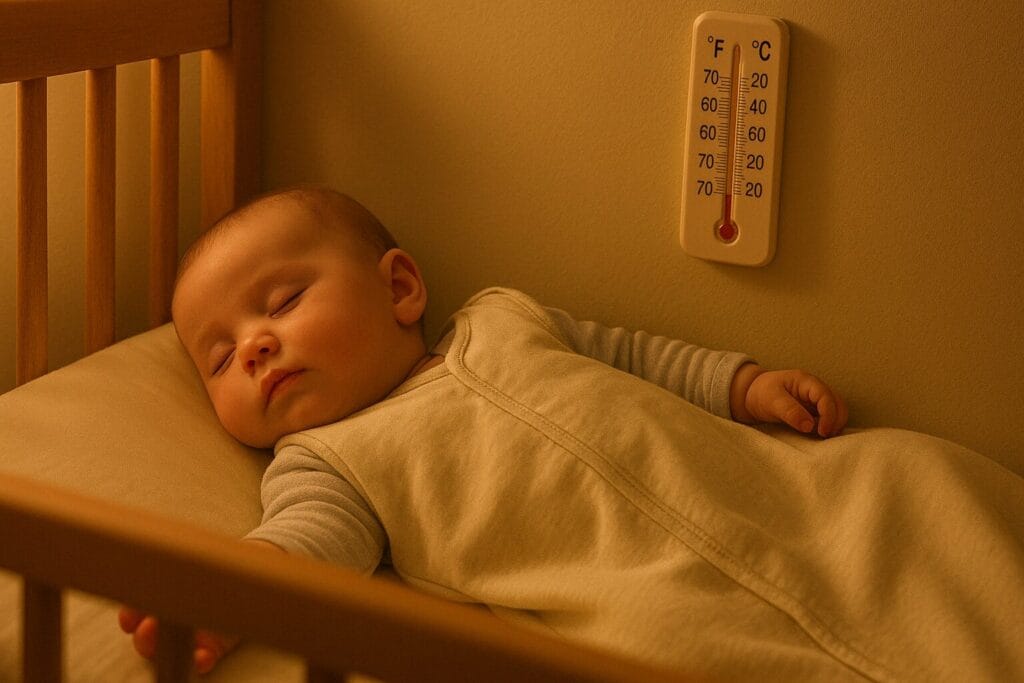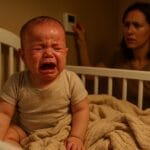Ensuring your baby sleeps soundly and safely is every parent’s top priority. One of the most significant factors influencing your baby’s sleep is their room temperature. The baby sleep temperature chart is crucial in helping parents ensure their babies are comfortable and safe throughout the night. When your baby’s room is too hot or cold, it can lead to discomfort, poor sleep, and potentially even health risks. This comprehensive guide will explore the importance of room temperature, the ideal temperature ranges for babies, and how to use a baby sleep temperature chart to create the perfect sleeping environment.
Table of Contents
Why Baby Sleep Temperature Matters
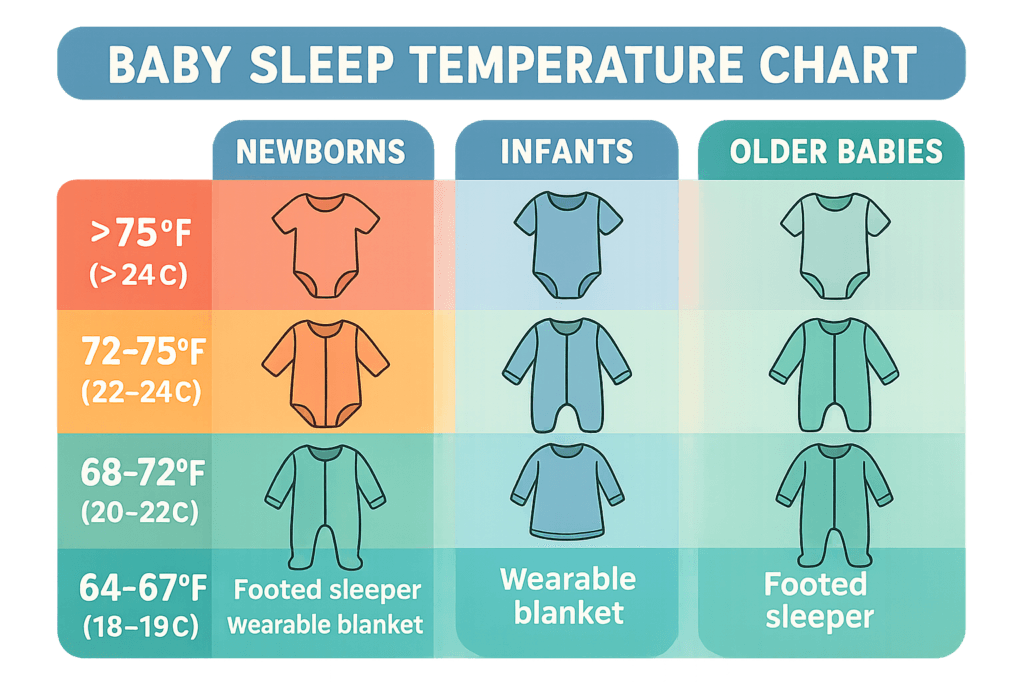
Before delving into the specifics of the baby sleep temperature chart, it’s essential to understand why room temperature is so important. Babies, especially newborns, cannot regulate their body temperature as adults can. This makes them highly susceptible to discomfort from both cold and hot temperatures. A baby sleep temperature chart helps guide parents to the optimal room temperature, ensuring their baby is neither too hot nor too cold.
The Risks of Overheating
Overheating is one of the most critical concerns for babies. When a baby’s room is too warm, they may be unable to cool their body efficiently, leading to overheating. Overheating is associated with a significantly higher risk of Sudden Infant Death Syndrome (SIDS). That’s why a baby sleep temperature chart is crucial to help prevent overheating by maintaining a room temperature within the ideal range.
The Risks of Being Too Cold
On the flip side, babies who sleep in an environment that is too cold can experience disturbed sleep. Cold environments can cause your baby to wake up frequently during the night or lead to other health issues like a weakened immune system. Babies who are too cold may also become fussy or have trouble falling asleep, which can cause sleep disruptions for both the baby and the parents.
The Ideal Temperature According to the Baby Sleep Temperature Chart
A baby sleep temperature chart is the best way to ensure your baby’s room is kept at the right temperature for optimal sleep. Generally, the ideal room temperature for babies is between 68°F and 72°F (20°C to 22°C). This range is comfortable and safe, preventing overheating and ensuring your baby won’t feel too cold.
However, their sleep temperature needs may shift slightly as your baby grows. Let’s break down the temperature guidelines by age group to help you fine-tune your baby’s sleep environment.
Newborns (0-3 Months)
Newborns are particularly vulnerable when it comes to temperature regulation. Because their bodies haven’t yet developed the ability to manage temperature changes, maintaining a consistent temperature between 68°F and 72°F (20°C and 22°C) is essential for newborns. A baby sleep temperature chart will help you keep their environment stable, critical for preventing temperature-related sleep issues.
Infants (4-12 Months)
As babies grow and gain more body control, they become slightly more capable of regulating their body temperature. However, infants still require an environment consistently within the recommended temperature range. The baby sleep temperature chart for infants suggests a room temperature between 68°F and 75°F (20°C to 24°C).
This range allows for some flexibility as your baby moves more, but monitoring the temperature closely and ensuring your baby is not exposed to extreme temperatures are critical.
Older Babies (12+ Months)
For babies older than 12 months, the recommended room temperature is slightly higher, ranging from 68°F to 74°F (20°C to 23°C). As your baby grows, they are better equipped to handle slight temperature variations, but it’s still important to stay within a comfortable range to help ensure a good night’s sleep.
How to Use the Baby Sleep Temperature Chart Effectively
Knowing the right temperature for your baby’s sleep environment is only half the battle. The other half involves ensuring that the room stays within that range, which requires some attention to detail. Here are the best practices for using the baby sleep temperature chart to ensure your baby’s room is always within the ideal range.
Use a Room Thermometer
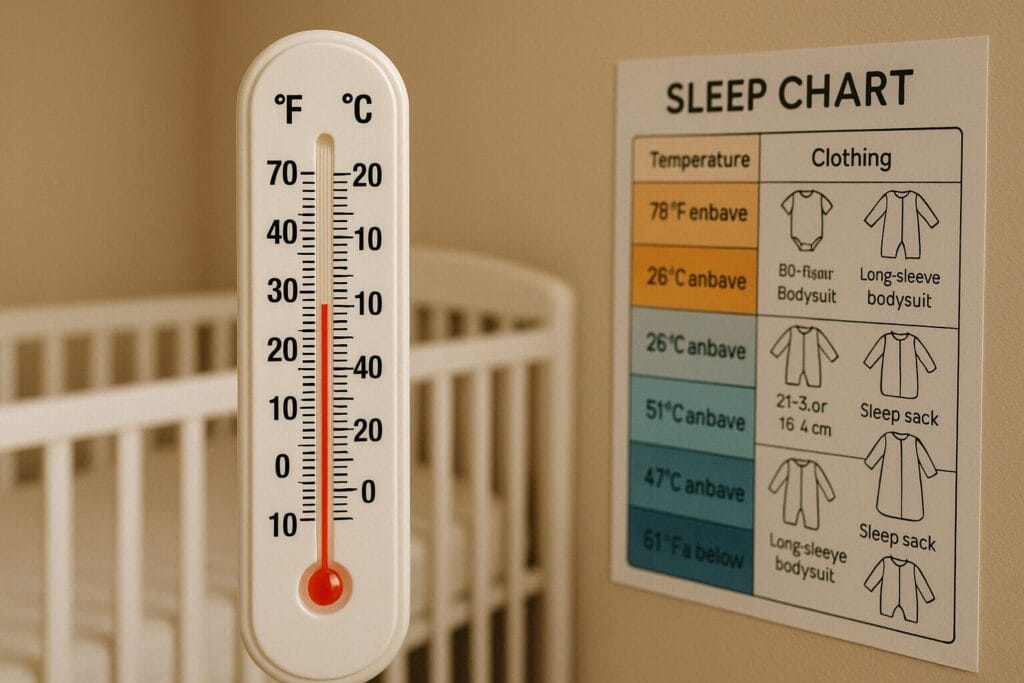
The easiest way to ensure the room temperature remains consistent is to use a room thermometer. This tool will help you monitor the temperature accurately so you can make adjustments as needed. A baby sleep temperature chart will guide you in interpreting the thermometer readings, but having an accurate way to check the temperature is key to keeping your baby’s room comfortable.
Adjust the Temperature Based on the Season
One of the challenges parents face is adjusting the temperature according to the season. In the winter, the room temperature may drop below the optimal range, while in summer, it can get too hot. Here are a few tips for dealing with seasonal temperature changes:
- Winter: Use a space heater or adjust the thermostat to maintain the room temperature within the desired range. Additionally, dress your baby in warm layers such as footed pajamas or use a sleep sack to help regulate their body temperature. Be careful not to warm the room, as overheating is still a concern in the colder months.
- Summer: When the temperature outside rises, be mindful of how cool your baby’s room is. You can use a fan or air conditioning to cool the room, but be sure not to make it too cold. Dress your baby in lightweight clothing and use breathable fabrics to help them stay cool and comfortable while they sleep.
Learn more about safe sleep practices and how to recognize signs your baby is too hot while sleeping in this comprehensive guide: Signs Baby is Too Hot While Sleeping: A Comprehensive Guide to Safe Sleep Practices.
Dress Your Baby According to the Room Temperature
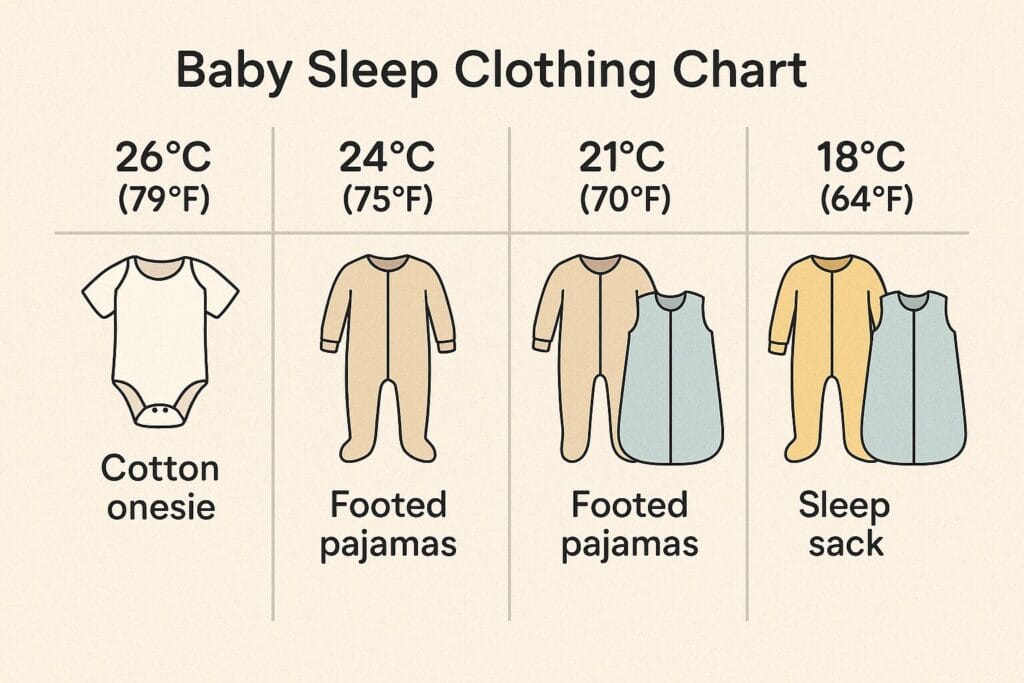
Your baby’s sleepwear plays a significant role in maintaining their comfort. When combined with the baby sleep temperature chart, choosing the right clothing ensures your baby stays at the right temperature throughout the night.
- Room Temperature 68°F – 72°F (20°C – 22°C): For this range, a lightweight cotton onesie or footed pajamas are ideal. A sleep sack can help regulate their body temperature while keeping them cozy.
- Room Temperature 72°F —75°F (22°C —24°C): In warmer temperatures, your baby should be comfortable in a short-sleeved onesie and a lightweight sleep sack or wearable blanket.
- Room Temperature Below 68°F (20°C): In cooler environments, consider a thermal sleep sack or a long-sleeved onesie to keep your baby warm without the risk of overheating.
Other Considerations for Baby Sleep Temperature
While using the baby sleep temperature chart is essential, there are other factors you should keep in mind to ensure your baby’s sleep environment is safe and comfortable.
Humidity Levels
Humidity can significantly affect how your baby feels in their sleep environment. A room that is too dry can lead to dry skin and respiratory discomfort, while a room that’s too humid may cause your baby to feel overheated. The ideal humidity level for your baby’s room is between 40% and 60%. A hygrometer can help monitor the room’s humidity levels, and you may want to use a humidifier in the winter months to maintain balance.
Safe Sleeping Practices
In addition to maintaining the right temperature, it’s important to follow safe sleep practices. Always place your baby on their back to sleep, and use a firm mattress with a fitted sheet—avoid soft bedding, pillows, and stuffed animals, which can be suffocation hazards.
Monitor Your Baby’s Comfort
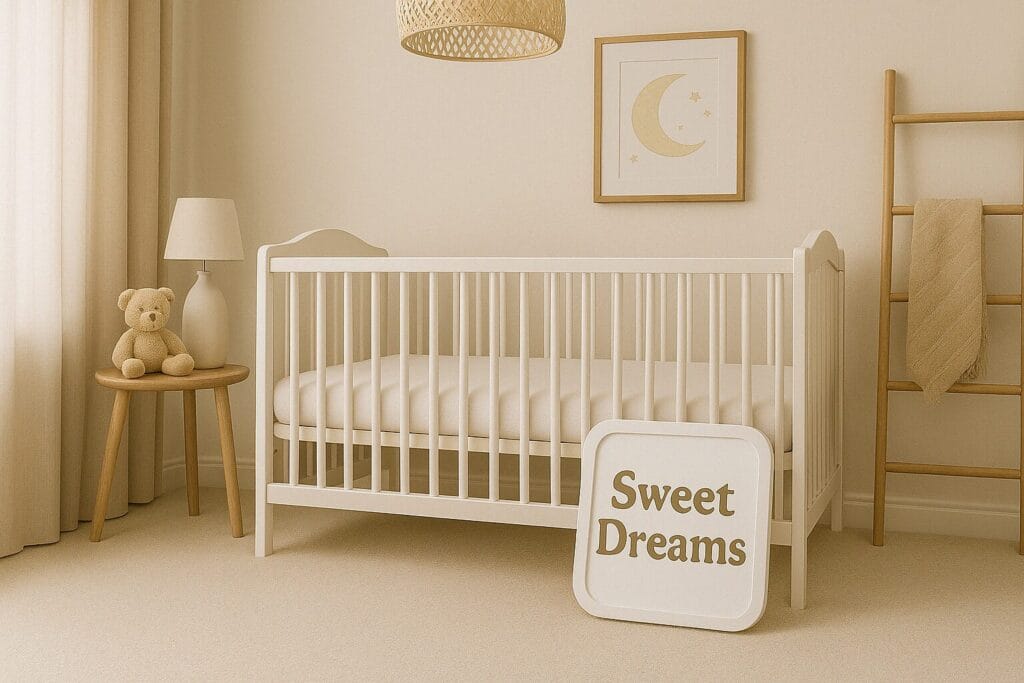
Even with the baby sleep temperature chart as a guide, it’s important to pay close attention to how your baby responds to their environment. Babies can’t verbally communicate discomfort, so observing physical signs is essential. If your baby seems too hot or too cold, you may need to adjust their clothing or room temperature.
Look for Physical Signs
The baby sleep temperature chart gives you a general idea of the ideal temperature for your baby’s room. However, if your baby’s skin feels too warm or they have flushed cheeks, they may be overheating. Conversely, if their hands or feet are cool, it could mean they are too cold. These signs can help you make adjustments, even if the room temperature is within the recommended range.
Adjust the Environment Based on Response
Even with the baby sleep temperature chart as a starting point, it’s important to make adjustments based on how your baby reacts. If your baby is sweating, restless, or waking frequently, it may indicate the room temperature needs to be modified. You can add or remove layers of clothing or use a sleep sack to fine-tune their comfort.
Creating a Personalized Sleep Environment
Every baby is unique, and their temperature needs may vary. The baby sleep temperature chart provides a baseline, but continuous observation allows you to create a personalized sleep environment. Adjusting the room temperature or using fans or heaters can help maintain the ideal conditions for your baby’s comfort.
In conclusion, the baby sleep temperature chart is a helpful guide, but monitoring your baby’s comfort is key. Watch for signs of overheating or being too cold and adjust their clothing or room temperature accordingly to ensure safe, restful sleep.
Struggling with a newborn who’s fussy at night but calm during the day? Discover the 5 proven causes and soothing solutions in our detailed guide: Newborn Fussy at Night but Not During the Day: 5 Unlock Proven Causes and Soothing Solutions.
Common Mistakes to Avoid
Over-bundling or Under-dressing
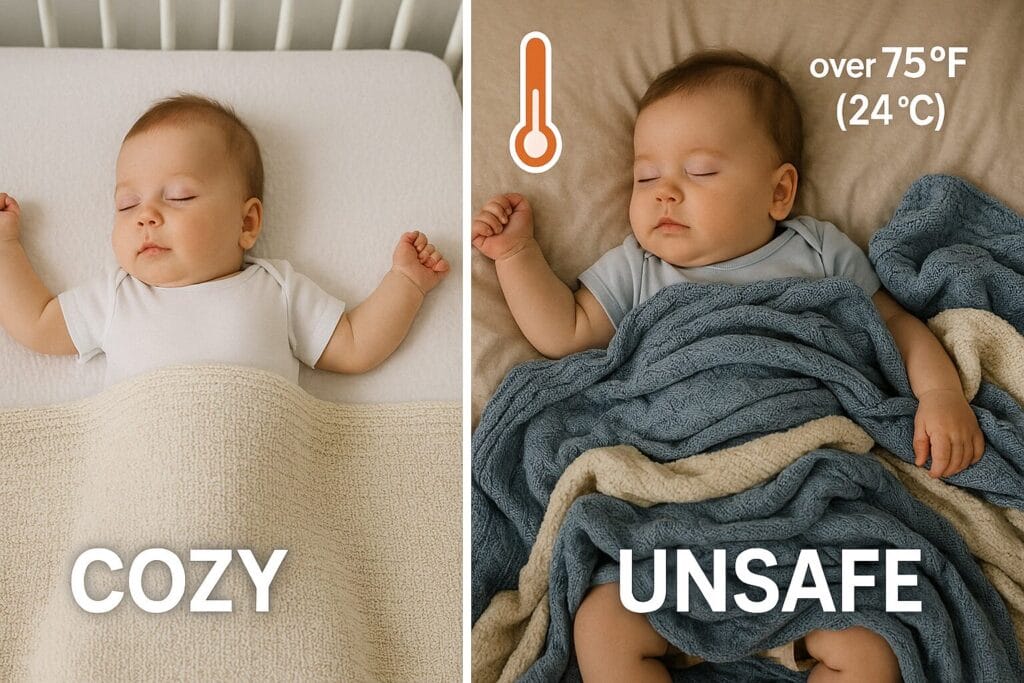
One of the most common mistakes parents make is over-bundling or under-dressing their baby for sleep. According to the baby sleep temperature chart, it’s important to dress your baby according to the room’s temperature. Over-bundling can lead to overheating, which is dangerous, while under-dressing can make your baby too cold and uncomfortable.
The baby sleep temperature chart provides specific clothing recommendations for different temperatures, helping you choose the right layers. In colder rooms, use thicker sleep sacks, and for warmer rooms, opt for breathable, lightweight outfits to keep your baby comfortable. Following these guidelines from the baby sleep temperature chart can prevent these issues and ensure your baby sleeps soundly.
Not Monitoring the Sleep Environment
Failing to monitor your baby’s sleep environment is another common mistake. Babies can’t regulate their body temperature like adults, so it’s essential to keep the room at the ideal temperature. The baby sleep temperature chart suggests that a room temperature between 68°F and 72°F (20°C to 22°C) is ideal for safe sleep.
Using a thermometer is key to maintaining the right temperature. The baby sleep temperature chart can help guide you in adjusting the room’s temperature using fans, air conditioners, or heaters. Regularly checking the room temperature ensures your baby stays comfortable and safe throughout the night.
Ignoring Signs of Overheating or Being Too Cold
Not noticing when your baby is too hot or too cold can be a serious mistake. Overheating can lead to discomfort and increase the risk of SIDS, while being too cold can disrupt sleep. The baby sleep temperature chart offers clear guidelines on the signs to watch for, such as sweating (for overheating) or cold skin (for being too cold).
By checking your baby regularly and using the baby sleep temperature chart to guide your choices, you can adjust their clothing or the room temperature as needed to keep them comfortable and safe.
When to Seek Help
When Temperature Regulation Becomes a Concern
If your baby consistently seems uncomfortable despite following the baby sleep temperature chart, it may be time to contact a pediatrician. Sometimes, babies struggle with temperature regulation due to underlying health issues, such as an infection or metabolic disorder. If your baby is excessively hot or cold even after adjusting their clothing and room temperature according to the baby sleep temperature chart, it’s important to seek medical advice.
The baby sleep temperature chart can help guide you in creating the perfect sleep environment, but if the temperature continues to affect your baby’s comfort and sleep, a pediatrician can help rule out any medical conditions that might be interfering with their ability to regulate their body temperature.
Signs of Overheating or Hypothermia
If your baby shows signs of extreme overheating (like sweating, flushed skin, or rapid breathing) or hypothermia (cold skin, shivering, or lethargy) despite following the baby sleep temperature chart, it’s crucial to reach out to your pediatrician immediately. While slight variations in room temperature can be managed, extreme symptoms indicate that something may be wrong.
The baby sleep temperature chart offers a general idea of ideal room temperatures, but if your baby is showing concerning signs related to temperature, your pediatrician can help determine if there is an underlying cause and how to address it.
Trouble Sleeping Due to Temperature Fluctuations
If your baby is consistently disturbed by temperature changes, resulting in poor sleep quality, you should consult a pediatrician. While the baby sleep temperature chart provides guidance on how to manage temperature, persistent issues like frequent waking or difficulty settling down despite adjusting the room temperature could suggest a sleep disorder or another issue.
In this case, your pediatrician will be able to assess whether temperature is truly the cause or if there’s an underlying condition that needs to be addressed. By following the baby sleep temperature chart and reaching out for professional advice when needed, you ensure your baby gets the best sleep possible.
Frequently Asked Questions About Baby Sleep Temperature
1. What is the ideal room temperature for my baby to sleep in?
The ideal room temperature for a baby is typically between 68°F and 72°F (20°C to 22°C). This range is recommended in the baby sleep temperature chart for safe and comfortable sleep. It’s important to keep the room within this range to avoid overheating or chilling your baby. You can use a thermometer to monitor the room temperature and make adjustments as needed.
2. How do I dress my baby for sleep based on the room temperature?
The baby sleep temperature chart provides guidelines for dressing your baby according to room temperature. For example, if the room is on the cooler side (below 68°F or 20°C), you may want to dress your baby in a warm sleep sack or layers. For warmer rooms (above 72°F or 22°C), lighter sleepwear like a cotton onesie is recommended to prevent overheating.
3. Can I use blankets for my baby at night?
It’s best to avoid loose blankets, especially in the first year of life, as they can pose a suffocation hazard. Instead, follow the baby sleep temperature chart for safer options, such as a wearable blanket or sleep sack, which can keep your baby warm without the risk of covering their face. The chart helps guide you on which sleepwear to use based on the room’s temperature.
4. How do I know if my baby is too hot or too cold while sleeping?
Signs of overheating include sweating, flushed cheeks, and rapid breathing, while signs of being too cold include cool extremities (hands and feet), shivering, and a pale appearance. Refer to the baby sleep temperature chart for guidance on dressing your baby appropriately. If you notice any of these signs, adjust the room temperature or their sleepwear accordingly.
5. Should I adjust the room temperature based on the season?
Yes, the baby sleep temperature chart recommends seasonal adjustments. In the winter, you may need to increase the room temperature or use extra layers to keep your baby warm. In the summer, using a fan or air conditioning can help maintain a comfortable, cool environment. Always monitor your baby’s comfort and adjust their clothing as needed.
6. Can I use a fan or air conditioner to cool the room?
Using a fan or air conditioner is fine, as long as you ensure that your baby’s sleep area is not too cold or drafty. The baby sleep temperature chart suggests a room temperature of 68°F to 72°F (20°C to 22°C), so if using a fan or AC, monitor the temperature regularly to ensure it stays within this range. Additionally, avoid placing the fan directly on your baby to prevent any discomfort.
7. When should I seek medical advice regarding my baby’s sleep temperature?
If your baby shows signs of persistent discomfort despite following the baby sleep temperature chart, or if they are consistently too hot or too cold, it’s best to consult a pediatrician. They can help rule out any medical conditions that may affect temperature regulation, such as infections or other health issues.
8. Can I use a fan in my baby’s room?
Yes, fans can help maintain airflow. However, make sure the fan is not blowing directly on your baby.
9. What should I do if my baby’s room temperature fluctuates?
Monitor the temperature regularly and adjust your baby’s clothing or the room’s temperature to stay within the ideal range.
Conclusion
Maintaining the right room temperature ensures your baby sleeps soundly and safely. The baby sleep temperature chart is a valuable tool for every parent, helping to guide you in creating the perfect sleep environment. Following the chart and monitoring your baby’s comfort can reduce the risk of overheating or getting too cold, ensuring your baby enjoys a peaceful night’s rest. Whether winter or summer, the right temperature and safe sleep practices will make all the difference in your baby’s sleep quality.
Using the baby sleep temperature chart effectively ensures that your baby sleeps comfortably and safely every night, contributing to their overall well-being and allowing you to rest easy, too.

